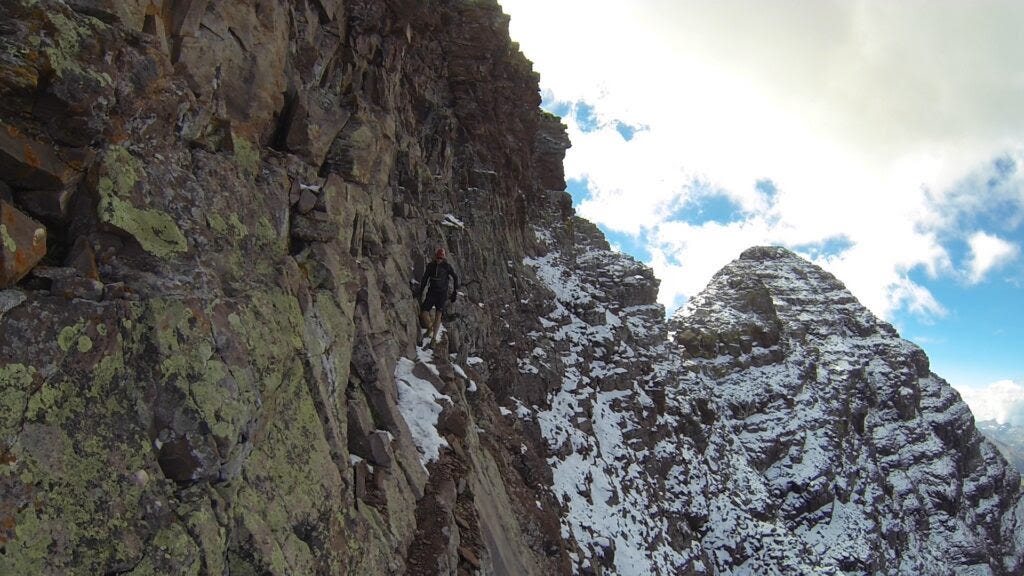October Hiking in Colorado
Your weather outlook for the month from guest writer Chris Tomer; meteorologist, mountain weather expert, and mountaineer.
The following is a guest post written by Meteorologist Chris Tomer, examining the weather patterns and changes you can expect up on the high peaks. A must-read before any hike you undertake this month.
Hiking in the “Shoulder Season”
I consider the month of October to be part of the "shoulder season" in Colorado. Cold fronts hit more frequently - every 3-4 days in the Mountains. This changes the complexion of hiking and mountaineering on the 13ers and 14ers.
I've experienced these rapid October weather changes over the years. Here's a flashback to Fall 2014 and a traverse of the Maroon Bells with a coating of snow above 13,700'.
I remember this traverse vividly with Jon. Back in 2014 it was customary to use conditions like this as a test of mountaineering skills. Training in difficult conditions forces you to improve a wide range of skills quickly.
You see this "snow cone" effect often in October with new snow coating the 13ers and 14ers above a certain elevation. It can be dry and quite pleasant at lower elevations.
Subscriptions are free, support independent writing, and ensure you never miss an edition.
Big Weather Changes Above 13,000’
Meteorologically, we see significant changes above 13,000' during the month.
<32 permanently by mid October above 13K
15 degree drop in high temps overall
Most daytime temps in the 40s at 13K by mid October
Baseline wind speeds increase
Cold fronts every 3-4 days
Stronger gusts with cold front passage
Dustings of snow on 13ers/14ers
Here's another example from October 29, 2016 with friend Ryan Kushner on one our favorites, Kelso Ridge.1 It had snowed an inch or two, clouds were swirling, wind was blowing to 40mph, and air temps were in the 30s.
We've come to enjoy these conditions, strangely, over the years. Ryan seems to feel right at home. A testament to his mental fortitude.
Changing conditions like this in October force you to start taking more gear. Heavier gloves, footwear, jackets, gaiters, goggles, traction, and ice axe to name a few.
Have fun and see you on the summit!
Meteorologist Chris Tomer forecasts weather for KDVR FOX-31 and KWGN Channel 2 in Denver. You can watch Tomer Monday-Friday on Channel 2’s Daybreak morning show from 4:30am-9am.
You can also subscribe to his blog for weather updates delivered straight to your inbox, or on YouTube for more in-depth and technical analysis of mountain weather.
Tomer earned a B.S. in Meteorology from Valparaiso University graduating with Honors – where he also played basketball. Tomer minored in mathematics and broadcasting.
Tomer is a fully certified meteorologist having earned the CBM and NWA Seal’s of Approval. Tomer also serves on the NWA panel of Television Seal evaluators. Chris has specialized knowledge of Mountain Meteorology.
Next Time on Cole’s Climb
“Clipping,” I yell.
My belay partner lets out an arm’s length of slack. I’m now in one of the more precarious positions a lead climber can find themselves in: far above my last piece of protection, with the system full of slack.
Lead climbing — like life — is often about finding opportunities to take breaks amid tough situations, and seizing on them.
I explore this in my upcoming edition of Cole’s Climb: “How to Take Breaks in the Busiest Situations.”
Look for it in your inbox this Thursday, October 7th.
I Want to Hear from You
Do you have a winter hiking experience that tested your limits? Tell us about it, below!
Cole here, again. For context, this is what Kelso Ridge looks like in the summer; the only time I've dared attempt it











Thanks for this guest post, Cole!
A few years ago I took a couple of visiting loved ones to hike in Rocky Mountain National Park. It was mid-October. The weather in Denver was in the 50s and sunny, and my friends couldn’t believe me when I said they would need winter gear on our hike (around 9,000 feet). I’ll forever treasure the looks on their faces when it was 20 degrees and blowing snow!